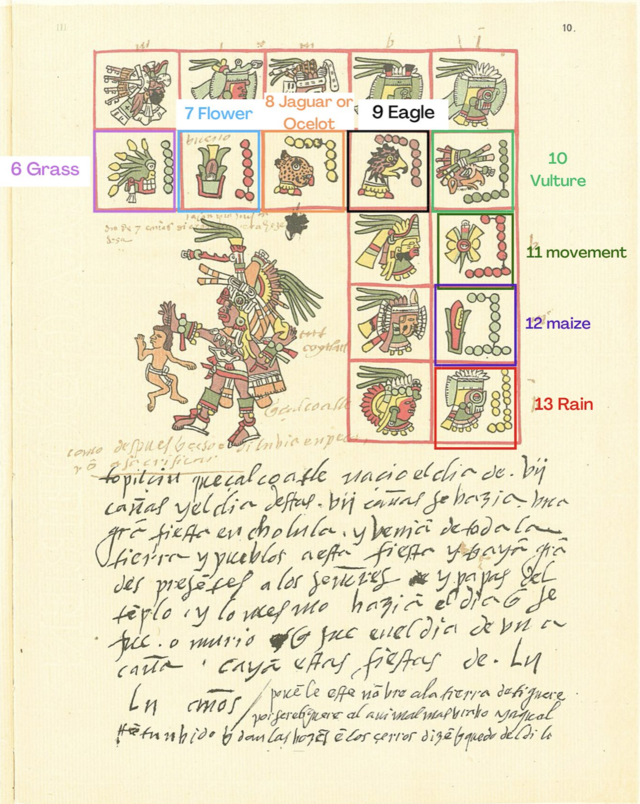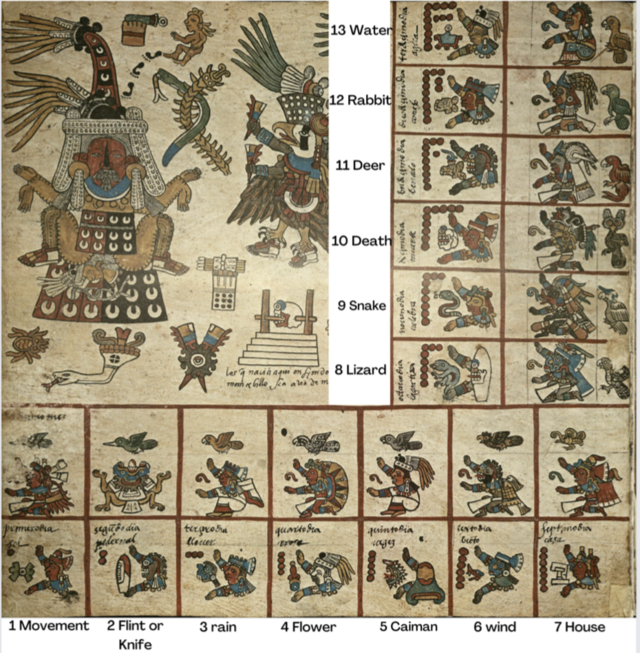Top Qs
Timeline
Chat
Perspective
Tōnalpōhualli
Aztec calendar From Wikipedia, the free encyclopedia
Remove ads
The tōnalpōhualli (Nahuatl pronunciation: [toːnaɬpoːˈwalːi]), meaning "count of days" in Nahuatl, is a Mexica version of the 260-day calendar in use in pre-Columbian Mesoamerica. This calendar is solar and consists of 20 13-day (trecena) periods. Each trecena is ruled by a different deity. Graphic representations for the twenty day names have existed among certain ethnic, linguistic, or archaeologically identified peoples.[1]



Remove ads
Description
Summarize
Perspective

The term for the Aztec day signs, tōnalpōhualli, comes from the root word Tona which means to give light or heat.[2] Tōnalpōhualli refers to the count of the days, made up of 20 day signs and a 260 day cycle. In Aztec society there were multiple intertwining calendars, the tōnalpōhualli, and the xiuhpōhualli which refers to the solar year of 365 days. The xiuhpōhualli was divided into eighteen twenty day months, and then an extra five days at the end of the cycle. Each day denoted by a different day sign and number, the double calendars were intertwined so that every 52 years the same combination of day signs and numbers would appear again.[2] The full tōnalpōhualli cycle would take place over 260 days and since each day was unique in number and symbol each had its own intrinsic meaning.[3] It is likely that the root of these units comes from the human body: the Aztecs would count using all digits on their body consisting of the 20 day signs.[4] The 260 cycle likely originated from womans’ gestational cycle, as from the time of the first missed menstruation cycle to the time of giving birth is roughly 260 days.[4]
The tōnalpōhualli as aforementioned consists of twenty different day signs or Trecenas, which in almost all representations are accompanied with a glyph depicting its character. The Aztec form of writing is largely pictorial and was a semasiographic system, meaning writing existed separately from spoken word.[5] The glyphs were recognizable to their meaning, and members of the population would understand what day it was and their current position in time.[5] Since the Trecenas would repeat every twenty days they were accompanied by a number from 1-13. Usually the day count was depicted by small circles next to the main glyph adding up to the juncture of that day.[2] The glyphs had to be understood by the population so there is a strong level of similarity in depiction of each trecena. However, the day count seems to be up to the discretion of the artist.[2] The first day of the 13 day cycle would be one crocodile (Cipactli) and continue until 13 reeds (Acatl). The next 13 day cycle would begin with one jaguar (Ocelotl) and continue until 13 death (Miquiztli). During this cycle the Trecenas would repeat making the day eight crocodile (Cipactli) and so forth. This pattern would continue until all 20 day signs had been associated with numbers 1 through 13. The Trecenas and numbers were two separate identities, the day five deer (Mazatl) did not represent there being five deer, nor was there any significance to the number five other than as a defining number. The five relates to the juncture of the day, it comes after day 4 and before day 6 in this specific 13 day cycle.[4] The 13 day cycles are subdivisions of the larger 260 day calendar, and they pertain to different rituals and times of the year.[6] The order of the days related to all aspects of life, they dictated when was the right time to plant maize and when to harvest. People felt that they would be vulnerable if the plantings and festivals didn't take place on the specified days.[3] The gods were also associated with different days, dictating when to hold a feast in each one's honor and which god to pray to.[4] For example, One reed is associated with Quetzalcoatl, while two reeds are associated with Omacatl.[7] The larger rituals would be on the first half of the 13 day cycles, but other important religious activities were done on specific Tonalpohualli days.[4] For instance, the feast of the sun was held on four movement.[4] Most things in day to day life were dependent on the correlating tōnalpōhualli—even given name. When born, formal names would be the day you were born; for example, 5 lizard (Cuetzpalin), and this would determine the child’s destiny.[4] Furthermore, marriages were dependent on the compatibility of the couple’s day signs and numbers.
Remove ads
Day signs
Remove ads
Gallery of day signs
Note that the symbols are arranged counterclockwise around the calendar stone.
- Flower, Rain, Flint, Earthquake
- Vulture, Eagle, Jaguar
- Reed, Grass, Monkey, Dog
- Water, Rabbit, Deer
- Death, Snake, Lizard
- House, Wind, Alligator
See also
References
External links
Wikiwand - on
Seamless Wikipedia browsing. On steroids.
Remove ads
























